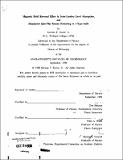Magnetic field reversal effect in inter-Landau level absorption and simulated spin-flip Raman scattering in n-type InSb
Author(s)
Favrot, Gervais F. (Gervais Freret), 1948-
DownloadFull printable version (11.31Mb)
Alternative title
Simulated spin-flip Raman scattering in n-type InSb
Advisor
Don Heiman and Peter A. Wolff.
Terms of use
Metadata
Show full item recordAbstract
This thesis is a theoretical and experimental study of inter-Landau level transitions in n-type InSb. Three main topics are considered: (i) The first observation was made of a magnetic field reversal effect in a spin-conserving inter-Landau level absorption transition. (ii) Advancements were made in the theory of intraband absorption and scattering processes. (iii) Experiments were carried out on the spin-flip Raman laser to examine crystal anisotropy. An important feature of this research is the prediction and observation of a striking magnetic field reversal effect in the inter-Landau level magnetoabsorption in n-InSb. The magnitude of the absorption associated with two transitions is observed to change by a factor of nearly 3 upon reversal of magnetic field direction. The effect results from the inversion asymmetry of the tetrahedral zincblende structure. The transitions which show the effect are the double cyclotron resonance and the double cyclotron resonance combined with spin-flip. The reversal effect involves the interference between two matrix elements which contribute to the absorption, one having tetrahedral symmetry, and the other spherical symmetry. The tetrahedral matrix element results from the inversion-asymmetry mechanism. The isotropic matrix element is associated with the wave vector-dependent electric quadrupole EQ and magnetic dipole MD absorption. The isotropic matrix element changes sign on reversal of q, and the one for inversion asymmetry changes sign on reversal of B, so the interference term changes sign on reversal of either q or B. Stimulated spin-flip Raman (SFR) scattering has been studied in applied magnetic fields up to 18 T. For 10-[mu]m pumping, the SFR laser output is dominated by structure associated with linear intraband absorption and shows significant anisotropy with regard to crystal orientation in the applied field. Calculations have been made for the transition matrix elements and absorption coefficients for the anisotropic intra-conduction-band magneto-optical transitions. The theory includes warping-induced transitions and the effects of band nonparabolicity in the Pidgeon and Brown model. Reasonable agreement between theory and experiment is obtained.
Description
Thesis (Ph.D.)--Massachusetts Institute of Technology, Dept. of Physics, 1998. Includes bibliographical references (p. 187-193).
Date issued
1998Department
Massachusetts Institute of Technology. Department of PhysicsPublisher
Massachusetts Institute of Technology
Keywords
Physics